
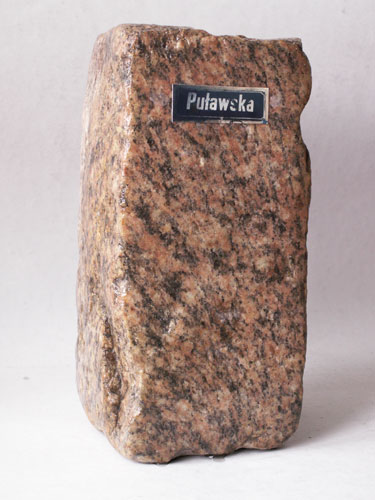
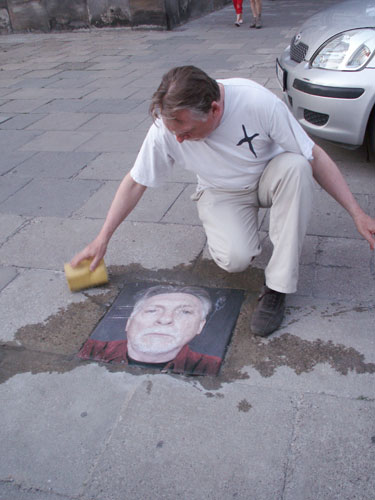
I am from and of the city
Today I know this better than ever. And I know I`ve always been part of the city, although I wasn’t aware of the fact before.
City streets mean a great deal to me. I am grateful to my parents for their lack of control over me when I was a youngster. Thanks to this, I could wonder about and hang around the city, smell and taste it at my will. By way of a digression: a collection of authentic cobble stones from the streets of Warsaw was shown in 1999 as part of my exhibition "Equal to a Stone" in Galeria Rzeźby BWA in Warsaw.
In the days of my early youth /the 1960s/ Warsaw, for Elek - my best friend at the time - and myself, was still a town within our reach and we felt it belonged to us. We practiced a certain type of extreme sport. We jumped in and off trams. Our regular route was Rakowiecka Street- Marszałkowska Street - Al. Jerozolimskie - Al. Niepodległości, which formed a square, along which trams would run. Our record time for completing the route was 18 minutes. I don`t remember how many trams we changed on the way, but we would jump on at the rear door /the doors were never closed then/ and at the nearest stop get off, only to get on again at the front so as to have a suitable chasing position and view of any tram that might be in front of us. The idea was to catch up with it on foot as fast as possible after jumping off the tram whenever the occasion arose. . Actually, we mainly ran along the rails chasing the trams and rarely using stops to get on and off. As a rule in our jumping off the trams we weren`t limited by their speed at that time, and jumping on a tram was always possible if we managed to reach the rear door.
This, however, is not what I wanted to boast about. While using the city transport so actively, we decided to mark the trams we "visited". The logo, which we called "our sign", was taken from an engraving found on the blunt side of the blade of a bowie knife I was given by my Uncle Hieronim. He was a ranger and a hunter in Rymanów, a remote place in south east Poland and he had a black pirate-like patch covering his missing eye, a souvenir from our war with the Russians in 1920. The sign - IIXII - was in fact nothing special, but when scratched quickly on the dirty surface of a tram-car with our fingernails, it remained there for some time and as we kept saturating the transport fleet with more and more of them we started encountering "our cars" more frequently. And this is due to this activity that I can claim priority in marking the city with my form of tags.
"As the twig is bent, so grows the tree". I quote the proverb in full here, mainly for the benefit of youngsters. I do not jump onto trams any more for a number of reasons. Let the first be that the doors today all close automatically. However, I do use trams sometimes. The buses too. I have always had great esteem for street artists. These proper ones. Concise content. Sharpness of the comment. Thoughtfulness. Saturator has gained my recognition.
I do not remember when exactly I thought of joining the sticking game. Perhaps in 2001. Texts only, no pictures. Photographs are another story. In 2005 I stuck 100 miniature photos onto the Warsaw busses because of the Month of Photography. It was my spontaneous reaction to the exhibition activities of my artist colleagues. Later I showed it in the form of a documentary in Mała Galeria ZPAF/CSW in Warsaw. The title was "Quite a Ride".
I evolve. I continue to stick texts on city buses and trams. On city walls I stick photos 10x15 cm in size. Each one is suitably placed and stamped with a round stamp holding the inscription "I am from and of the city", with my initials JB in the middle.
A new and intriguing place is basement windows. They appear in rows at an equal distance from one another, a form of a gallery. I stick photos on them. This activity is called "ground art" which defines the character of the photos. But there is also place there for stickers. Not tiny ones, though, but bigger in size, so they are legible. Mega stickers. With corresponding content.
There clears the way for yet another subject. It is called "Against Edges" and it`s about smoothing corners. It concerns fighting against a vertically exposed right angle. We`ll see what comes next. I am extremely interested in pavements. A lot has been done in this area, which has also included my fair share. However, I feel I want to do something new, something personal which will show that I am truly from and of the city.
I earn my living as a teacher of English and philosophy at a secondary school. I am 59 years old.
Some examples of stickers:
Oh, these people.
It`s raining. So what.
The young ones are asked not to be so young, the old ones to be.
Already not there, where you started from, not there yet, where you are going. A journey, a short break in your c. v.
It`s a long way, it`s time to think, but what about?
Maybe we`ll get off elsewhere, but we`re going the same way, brother.
Be happy with what you are not suffering from today.
What you would never give away, what you can`t do without, what you have because you do, and what is completely useless that you carry with you.
Mind your shoes or you will spoil the parquet floor with the snow.
Although you`re only commuting home, welcome traveler.
You are right. And me?
Not everything has been screwed up today.
Jacek Bąkowski
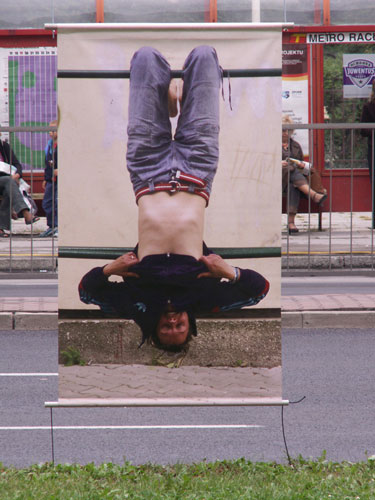


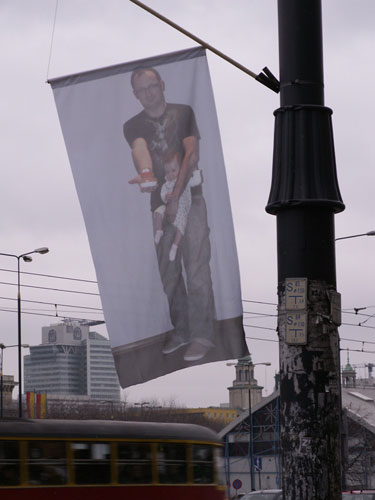
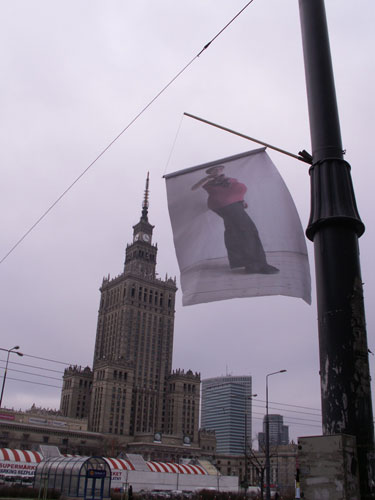
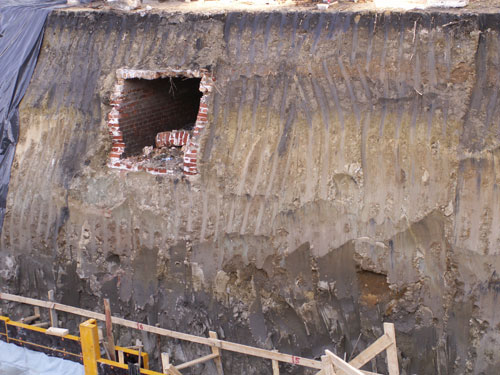
City without sharp edges
Jacek Bąkowski’s urban works are made precisely in my favourite scale. Unlike his "gallery" works they are not especially philosophical - at least from the point of view of the viewer. The artist knows that the street is not a good place to make the viewer rack his brains painfully. He knows that good street-art which breaks our daily routine lets us see trivial places from new points of view, in a seemingly well-known but usually completely untamed space. It does not force us to do anything though it engages us on the emotional level.
The artist’s intrusions in public spaces are of two kinds: the first one means creating strange rituals as in the case of photographs, glued on in carefully selected places and marked with a special stamp. Each photograph is taken twice - at first as a "pure" photo and then with a pedestrian who looks at it. Such actions resemble Jacek’s earlier projects, like Linia mojego losu [Line of my Fate] in which he established his daily "vector" with the help of the people he met in the street, or the action going back to the dark, gloomy days of communist Poland when he cleaned the windows, revealing sad faces of people riding on a dirty tram.
The second kind contains works of a larger format, displayed in busy places and hard to miss. Od sztuki nie uciekniesz [You Can’t Run from Art], Ludzie kochani [Loved People] or the pavement slabs from Długa street have vivid, life-size heroes with whom it is easy to identify. People of different ages performing exercises on a clothes-horse, as the author himself says, or unselfishly reaching out to us with a proverbial gift gain our confidence. Pedestrians approached in the street feel that this action is for them and that what made the artist intrude into this urban space, to include his own face and the figures of his friends in it was not only the need of self-expression. That he is not just marking his territory but also giving something to the city and its inhabitants, presenting them with meaning and creating emotional bonds between people.
He usually carries out his projects without permission, illegally, which provides interesting observations from the point of view of social engineering - it turns out that nobody, including city guards and policemen, bothers a man in a worker’s overalls who surrounds his working station with yellow tape saying: "Caution".
Jacek Bąkowski is also a collector - of objects and situations. Photographs, cut-outs and torn letters, found in the street, garbage cans or the attic, are later glued in an equally untrustworthy book containing a catalogue of these things. He has been also immortalized, "accidentally" stepping into the frames of pictures that people take in front of various tourist attractions.
We talk a lot today about the revitalization of the city. I believe that we cannot succeed restricting ourselves only to new investments - as the key to success lies in the curing of relations between people and space, in the renewal of feelings, as "revitalization" can be only achieved through emotions. In order to succeed we must remove "sharp edges" from the city, as Jacek Bąkowski literally does in his latest project.
* * *
I cannot live without the city, although it stinks, causes stress, although there are too many people around, there is too little silence, too little intimacy and too much loneliness. I cannot live without the city’s tension, nervousness and chaotic grace, its unfunctional ugliness and unfriendly space. The imperfection of the city - like human imperfection - causes my affection: the city is so incorrigible and so amusingly self-confident.
This is an exhibition of affection. It is about the relation between the city and the artist. The artist who claims that he is every inch a city guy. The city who like Cassandra from Szymborska’s poem "forgot that it could be beautiful".
Klara Kopcińska
Next exhibition
9.05.2008
Copyright ©2008 Galeria FF ŁDK, Jacek Bąkowski, Klara Kopcińska